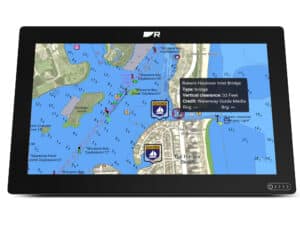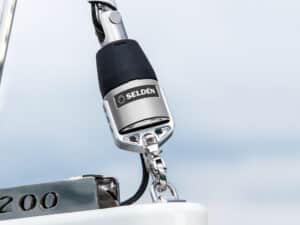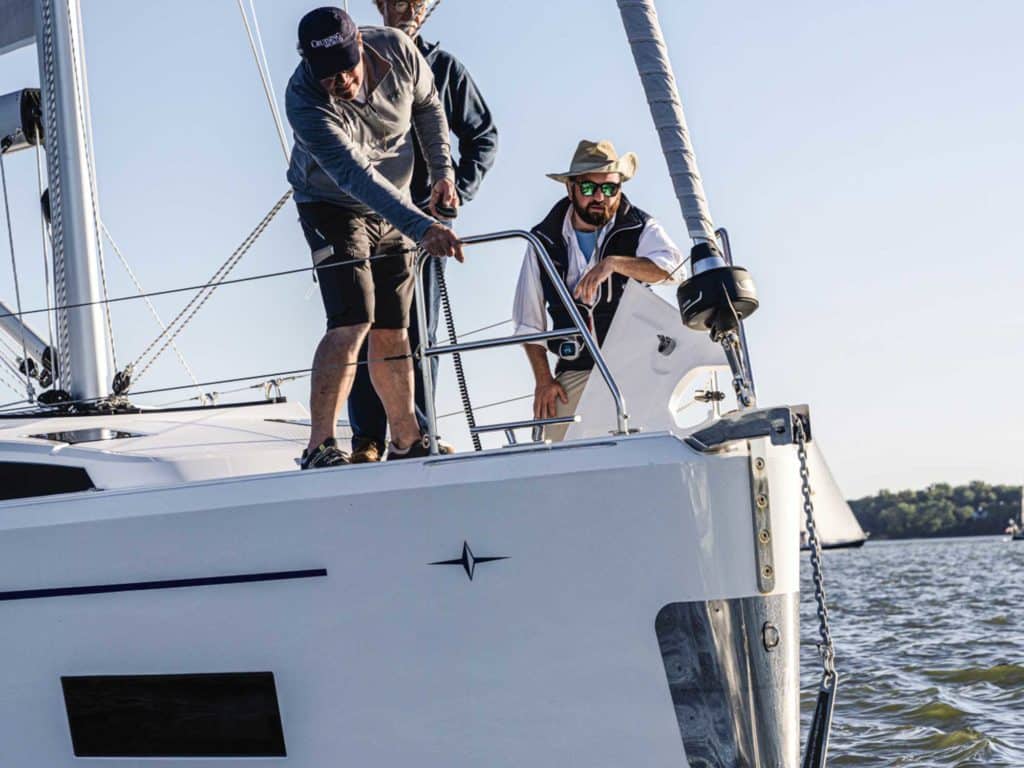
I still remember (robustly) arguing with my dad when he announced his plans to add a windlass to the J/44 he owned. He was thinking of easy anchoring. I was thinking of weight and the boat’s ability to hit its polars. I lost that fight, and I’ll admit to having some smoldering feelings—until we went cruising and I was charged with anchor retrieval. I reached down to start sweating in the 7-to-1 scope and the big Danforth anchor, until I saw the windlass foot switch. I remember pulling in the rode until it came vertical, waiting for my dad to break the anchor’s grip by nudging the boat forward with the engine, and then nonchalantly employing the switch, hoping he wouldn’t notice. No dice.
Bottom line: As a racing sailor, I wasn’t going to admit that the windlass was an upgrade, but there’s no question that it allowed my parents to enjoy years of additional cruising, while also saving me from back pain more than once.
The premise behind a windlass is simple: It employs power and mechanical advantage to make it easier to retrieve a vessel’s ground tackle and feed its rode into the anchor well. To do so, over time, windlass design evolved into two camps: horizontal and vertical, allowing boat owners or, more likely with new boats, the builders, to select equipment that best fits their particular yacht.
While high-quality windlasses are effective and dependable, a cost-cutting trend emerged in the 1970s and 1990s whereby boatbuilders offered windlasses as optional—not standard—equipment. As a result, many cruising boats were delivered sans windlasses. Flash-forward to the 2020s, and many of these boats are now changing hands. Their new owners, however, are less interested in footing chiropractic bills. Here’s a look at how a windlass works, the design and installation considerations involved, and the benefits it provides.
The Big Picture
A windlass functions as part of a larger system that includes the anchor, sometimes a swivel and chain, sometimes rope, some sort of a snubber or chain stopper, the anchor roller, the windlass itself, the anchor well, the windlass controls, and the windlass’s power supply. All of these individual pieces of equipment need to be correctly spec’d for the system to work properly.
“Start with what size anchor you’re going to use,” Harcourt Schutz advises. He is Lewmar’s senior director of aftermarket sales. He explains that the total weight of the boat’s ground tackle (not just the tackle that you expect to deploy) should represent one-quarter of the windlass’s working load. “It’s based on the anchor and rode, not the boat’s displacement. The anchor and rode are what you’re picking up. If you already have the rope and chain, match what’s there.”
If you’re starting from scratch, Fred Cook, president of Schaefer Marine, advises that not all chain is created equal. “I wish everybody would use high-test chain,” he says, adding that while this is more expensive than a standard galvanized marine alloy, it delivers considerably greater strength.
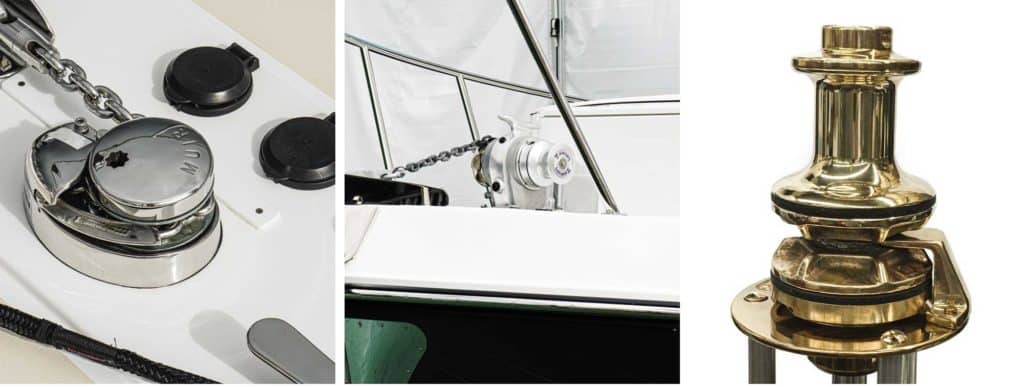
Cook says that the windlass’s chain wildcat, or gypsy (the coglike mechanism that controls the chain), must be spec’d to match the specific chain with which it will be paired. (Wildcat is the term typically used in the States; gypsy is preferred by Brits. To further confuse matters, in the US, an additional drum around which an anchor rope is wound is called the gypsy; the Brits call it a warping head.)
Wildcats typically are modular, and Cook suggests that cruisers mail a small section of chain to the windlass’s manufacturer (or distributor) to ensure that the chain wildcat’s web (that is, the teeth that engage the chain links) is properly matched.
While chain-and-rope rodes are common in North America, this isn’t the international norm. “No one uses rope except the US. Everyone else uses all-chain rodes,” says Jim Thomas, Imtra’s product manager for Lofrans and Muir anchoring products. He says rope-to-chain rodes evolved in the 1990s as a cost-cutting measure. These setups are rigged with the chain attached directly to the anchor on one end and spliced to rope (typically three-strand) on the other. While this setup reduces bow weight (“aah,” the racing sailor says), anyone who might eventually want an all-chain rode should consider this when spec’ing their windlass.
Swivels are sometimes situated between the chain’s last link and the anchor. Thomas notes that swivels are helpful in removing twists from the anchor rode during recovery. Meanwhile, if the anchor-roller wheel has a notch or a groove, this helps in aligning the links for entry into the gypsy, he adds. And the swivel’s
articulation helps align the chain as the anchor is pulled onto the roller. Additionally, swivels can help a set anchor negotiate windshifts and rising and falling tides, but Thomas and Schutz are both quick to point out that each additional proverbial link in the chain could be a point of failure. Because of this, both experts encouraged customers to use only high-quality swivels.
Any boat that’s equipped for anchoring with a windlass should have a bow-mounted anchor roller, which safely contains the anchor on deck and helps keep the rode in line with the windlass. As mentioned, it’s important to ensure that the roller’s shape matches the profile of your anchor chain.
There’s still more to note when it comes to assessing a vessel’s anchoring system. “Anchor lockers are unfriendly environments,” Schutz says of the belowdecks space where the rode is stowed. “They’re oversaturated with salt air.” This is a result of the inevitable water and harbor mud that windlasses raise along with the hook. The rub is that anchor wells usually contain the windlass’s power cables and, depending on the design of the windlass, its gear box. As a result, experts suggest that cruisers employ a bow hose or shower to rinse the rode as it’s hoisted, and to give the windlass, the anchor, and its rode freshwater rinses when possible.
Up and Down or Sideways
As mentioned, there are two common windlass designs: horizontal and vertical. While both retrieve anchor gear, the drive shaft on horizontal windlasses is horizontal, while vertical windlasses employ vertical drive shafts. This means that the chain wildcat on a horizontal windlass spins like a Ferris wheel, while the chain gypsy on a vertical windlass turns like a merry-go-round.
“Horizontal windlasses don’t have as much contact with the chain,” Thomas says, adding that the wildcat on a horizontal windlass typically has 110 degrees of chain contact. Conversely, “a vertical windlass has 270 degrees of surface contact. Vertical windlasses are better with rope-and-chain rodes, while horizontal windlasses are better-suited for all-chain rodes.”
Because of their fixed-volume nature, anchor wells often dictate how much rode one can carry, and they can influence one’s purchase decisions. “The distance between the windlass to the top of the line stack in the locker matters,” Schutz advises, adding that horizontal windlasses work best if this distance is at least a foot, while vertical designs work best when there’s 12 to 18 inches separating the windlass from the top of the line stack.
The other major design difference involves how much of the windlass is situated abovedecks. Horizontal windlasses are typically entirely deck-mounted. This frees up bow-locker space, but they occupy more deck real estate than vertical windlasses, which typically employ a belowdecks gear box. While Thomas advises that deck thickness can sometimes steer purchase decisions, given that most vertical windlasses use drive shafts that top out at 5 inches, Cook points out that custom shaft lengths can usually be accommodated. That said, unless you sail a wooden classic, odds are good that your fiberglass deck is only an inch or two thick.
Besides their design orientation, there are a variety of ways to control their operation. One common way is to employ deck-mounted foot switches, with one pedal lowering the rode and the other reversing the direction of the wildcat to retrieve it. Manufacturers also offer handheld controllers, wireless key-fob-like controls and even helm-mounted controls.
Lowering an anchor and its rode is fairly straightforward. Some cruisers install chain or rope counters in the system to help quantify the amount of deployed scope. Others paint the chain and rode at regular intervals or use a variety of plastic or cloth markers. It’s worth noting that at present, windlasses still employ solenoids to control the direction in which the wildcat turns. This means that windlasses have yet to become NMEA 2000 compatible, and therefore they currently cannot be controlled via the vessel’s chart plotter, a networked smartphone, or a digital-switching system. However, the experts interviewed for this story suggest that NMEA compatibility is coming in the next year or two.
Put It to Use
Once the anchor is set and the scope properly adjusted, experts suggest transferring the load off the windlass’s gear box and onto independent hardware. If you’re running a chain-to-rope rode, the easy solution if all of the chain is out is to tie the rope to a bow cleat. If you’re using an all-chain rode, manufacturers offer various hooks and/or snubbers that attach to a cleat and to a link in the chain, thus transferring the load off the windlass. As an aside, most modern catamarans come with a bridle arrangement that’s been pre-installed and which keeps the rode centered between the two hulls.
One of the smartest things anyone told me about sailhandling involves constantly looking at the sail or running rigging that’s affected when jumping a halyard or spinning a winch to ensure that something isn’t accidentally overloaded. Windlasses are no different. All experts agree that it’s wise to station one crewmember at the bow and another at the helm for anchor-retrieval work. They all also strongly recommend keeping the engine in gear (low RPM) and using it to drive the boat toward the anchor, with the forward crew either manually sweating in the rode or using the windlass. Once the rode is taut and near-vertical, it’s best to use the engine—not the windlass—to break the anchor’s grip on the seafloor. Once the hook is free, the crew can reengage the windlass, keeping a constant eye on things to ensure that the anchor roller or bow section isn’t damaged by overstraining the system once the anchor is on board.
If used properly, windlasses can greatly simplify anchor retrieval, but it goes without saying, just as with any high-torque system, it’s critical to pay attention and keep one’s hands clear of lines and moving parts.
As with all electrical systems, windlasses require DC juice. In a retrofit, this means an owner will typically have to run two, or possibly three, heavy-gauge cables forward to the bow from the house batteries. If you have a bow thruster installed that’s serviced by a local battery, this well of DC power can service the windlass too. The experts stressed the importance of situating a suitably sized windlass breaker as close to the battery as possible. “The circuit breaker protects the wires and the windlass motor,” Thomas says, advising that it’s wise to use thermal breakers.
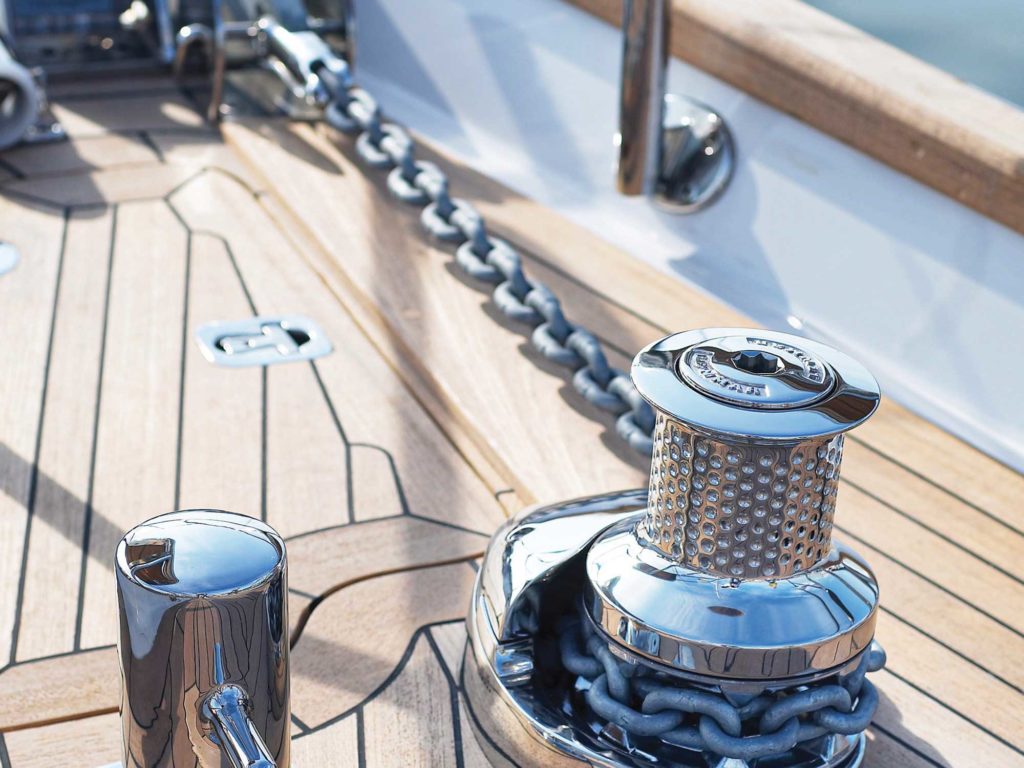
Given that boatyards typically require two days of labor to install a windlass aboard a 40-footer, it’s tempting for do-it-yourselfers to tackle a windlass refit on their own. “It’s pretty straightforward, but you need to be comfortable cutting holes in fiberglass,” Schutz says, adding that vertical windlasses usually necessitate larger apertures. “It’s not super easy, but if you’re comfortable with power tools, it’s not a deal-breaker. Running the wires is the hardest part.”
Maintenance is the last major consideration. Aside from keeping the rode clean and occasionally rinsing it with fresh water, it’s important to use your windlass several times per season (more is better) to ensure that the lubricating oil inside the windlass’s case is evenly distributed along its internal worm drive. “The worm gear is set in oil halfway,” Cook says. “The worm gear can rust out above the oil” if it’s not regularly used. Cook also suggested periodically checking your windlass’s seals to ensure that water isn’t entering the casing and affecting internal oil levels. Schutz recommends that owners with vertical windlasses keep the belowdecks componentry properly painted to avoid rust or corrosion—in other words, touch up nicks and dings. Thomas also recommends keeping the system’s clutch cones clean and greased.
Provided that users apply proper care and maintenance, a modern windlass should provide years of great service. And while there’s no escaping the added bow weight, this matters only if you’re more interested in winning pickle dishes than enjoying peaceful nights in beautiful locales with your friends and family.
David Schmidt is CW’s electronics editor and occasionally writes on other gear topics.
Vendor List
Bainbridge distributes Italwinch:
bainbridgeintusa.com/italwinch
from $1,060.
Imtra offers windlasses from Muir and Lofrans:
imtra.com; from $1,200.
Lewmar:
lewmar.com
from $1,000.
Vetus distributes Maxwell windlasses:
vetus-maxwell.com
from $2,210.
Quick Spa:
quickitaly.com
from $1,500.
Schaefer Marine carries the Ideal windlass brand:
schaefermarine.com
from $4,000.



